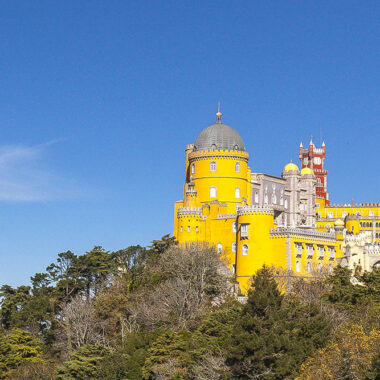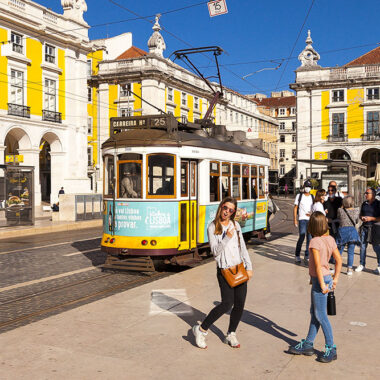Sintra sits on the western outskirts of Lisbon and is home to the spectacular Palácio Nacional da Pena, a Disneyland-esque castle constructed on the order of King Ferdinand in 1842. The palace is unsurprisingly a UNESCO World Heritage Site and also one of the Seven Wonders of Portugal (along with the monasteries we visited around Nazaré). The national park in which the palace is located is also home to a number of other monuments, notably the Castelo dos Mouros, a sprawling medieval structure built by the Moors in the eighth and ninth centuries. The walls and turrets of the castle are visible from distant Lisbon on a clear day. With so much on offer we kind of had of pick and choose what to visit around Sintra, one could easily spend a few days hiking through the entire national park to fully take in all the relics. It was also one of the more pricey historical sites we’d visited in Europe: for the four of us just to visit thePalácio Nacional da Pena and Castelo dos Mouros it was more than US$100.
It was a roughly six mile/10 kilometer roundtrip walk from our digs in Sintra through the old town, up to the Castelo dos Mouros and still higher to Palácio Nacional da Pena. The lower portion of the national park was an adventurous maze-like hike through cobblestoned walkways and stone staircases surrounded by some incredibly manicured gardens. The greenery just went on and on… The more than 200 hectare/500 acre gardens were created at the same time as the palace by order of King Ferdinand II, and were intentionally populated with plants from all over the globe: North American sequoia, cypress, magnolia and western red cedar, Chinese ginkgo, Japanese cryptomeria, and a wide variety of ferns and tree ferns from Australia and New Zealand. The palace itself was visually magnificent, the bright reds and yellows of the main towers intermingled with a beautiful array of tiled facades that are so symbolic of Moorish and particularly Portuguese architecture*. It really was like something out of a Disney movie. We passed by the Penedo da Amizade – the Cliffs of Amizade – on our way up to the castle and then again on the way back down, the kids were enthralled by the climbers grappling across the granite faces. The scrappy Portuguese climbing guide with whom we chatted described the cliffs as Portugal’s Half Dome for rock climbing.Penedo da Amizade was a long way off Half dome, but very fun to watch the climbers on their way up the wall all the same.
*Photography note: Palácio Nacional da Pena is tricky to photograph because it sits on a hill covered in tall trees. If one has a telephoto lense, Cruz Alta is a perfect spot in the morning light but is too far away with a standard zoom or wide angle lens. If one can clamber up on top of the rocks of Alto de Santa Catarina they provide an unobstructed view in the winter morning sun. Up close, you’re pinched right against the palace walls when exploring it so a wide angle less (16 millimeter focal length or less) is a must. Just in case anyone reading this visits, don’t want you paying the steep entrance fee and not getting any good pics!
Sintra’s old town below thePalácio Nacional da Pena was very quaint, its narrow alleyways filled with tiled facades, restaurants and a plethora of souvenir stores. The proximity of Sintra to Lisbon meant by lunchtime the old town andPalácio Nacional da Pena were filled with scores of tour groups on day trips from the capital. The difference in the atmosphere of the old town between the morning – when it was empty – and the afternoon – when it was completely jam packed – was astonishing. We couldn’t visit Sintra without sampling the town’s signature liqueur: ginja or ginjinha is a local specialty made by infusing ginja berries (sour cherries) and spices in alcohol, and was served in a small dark chocolate cup. Lisa was a big fan. Me, not so much, it reminded me of those sickly sweet liqueur chocolates that vendors often leave around Christmas time. Max was pretty jazzed on the non-alcoholic version, disappearing during our stroll through old town to buy himself a second round!
There were some beautiful beaches along the coastline to the west of Sintra, after we were done with the palace and old town we zipped out to Praia da Adraga located a short drive from our apartment. I committed to the kids that if the sun came out from behind the clouds I’d go for a swim, and of course the clouds broke and bathed us in sunlight… The kids couldn’t resist and followed me in, the two of them are such water babies. It was actually warmer in the water than the 19°C/66°F outdoor temps. Praia da Adraga was a perfect bodysurfing beach, it’d be an amazing spot during the summer months. I thought our days on the beach on The Alentejo and Vicentina Coasts were going to be our last until Australia, but it was great to sneak in another one near Sintra.































































Portugal is like a step back in time and so well preserved. Ones imagination of the days of old can run wild!
I’m so happy for your final beach time before leaving the continent.